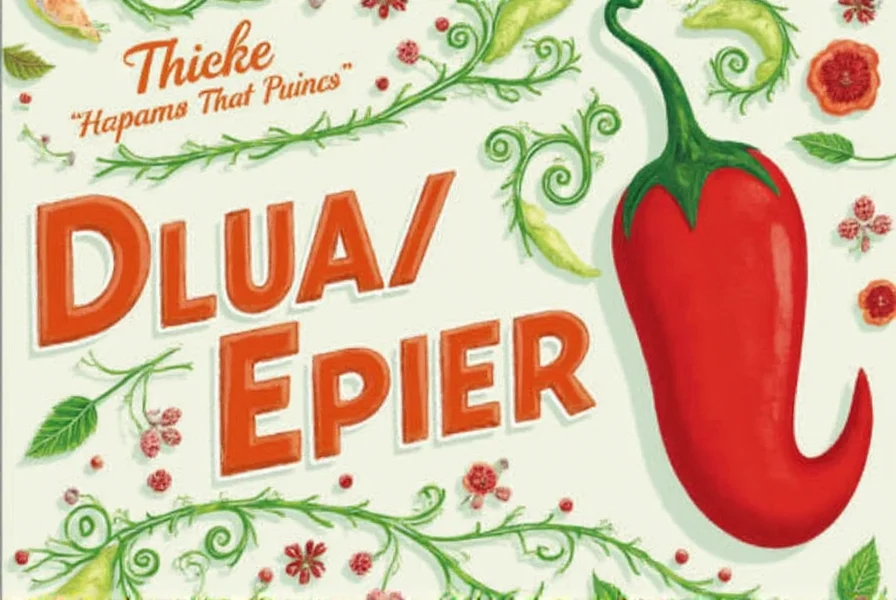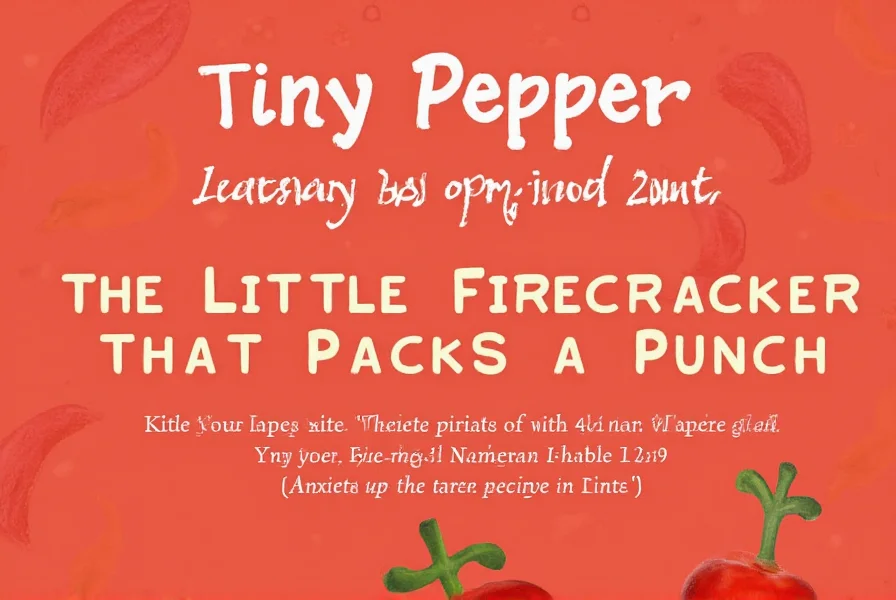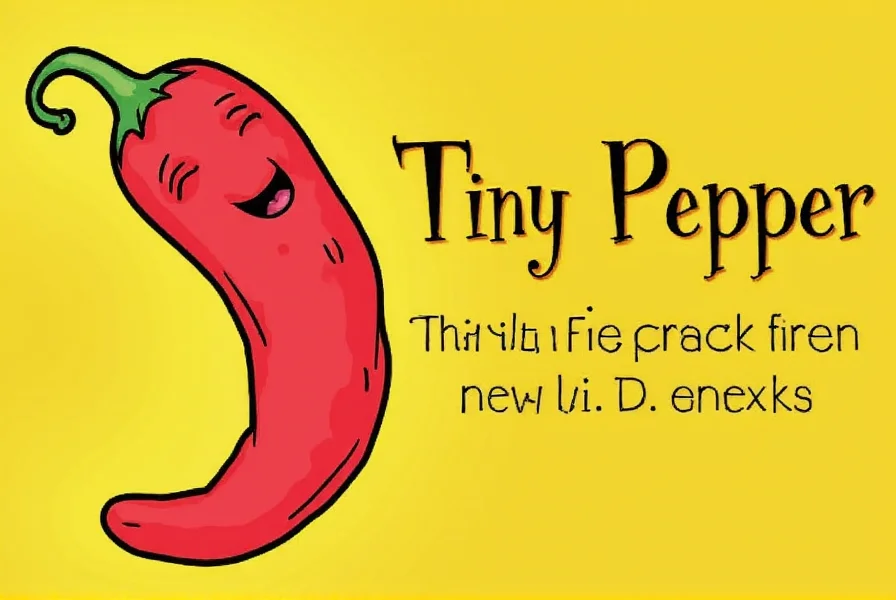Table of Contents
Introduction to Small Chili Peppers
Small chili peppers like Thai bird's eye chili are renowned for their intense heat and complex flavors despite their miniature size. This guide clarifies common misconceptions about "tiny peppers" and provides accurate, science-backed information on handling, cooking, and selecting these potent ingredients. For food safety and culinary success, understanding the true characteristics of small chili varieties is essential.
What Are Small Chili Peppers?
The term "tiny pepper" is often misused. In reality, there is no standardized "tiny pepper" variety. Instead, several small chili types are commonly grouped under this informal description. The most accurate reference is the Thai bird's eye chili (Prik Kee Noo), which typically measures 1-2 inches in length and is the smallest widely-used chili pepper globally. Other small varieties include:
- Thai bird's eye chili: 1-2 inches long, 50,000-100,000 Scoville units
- Habanero: 1-2 inches wide, 100,000-350,000 Scoville units (larger than bird's eye but still considered small)
- Serrano: 2-4 inches long, 10,000-25,000 Scoville units
Important clarification: Poblano peppers (4-6 inches long, 1,000-2,000 Scoville units) are not small chili peppers. They are large, mild peppers commonly used in Mexican cuisine. Including them in "tiny pepper" discussions is a widespread misconception.
| Pepper Type | Heat Level (Scoville Units) | Typical Size | Flavor Notes |
|---|---|---|---|
| Thai Bird's Eye Chili | 50,000–100,000 | 1-2 inches | Smoky, citrusy, slightly sweet |
| Habanero | 100,000–350,000 | 1-2 inches wide | Fruity, floral, with tropical notes |
| Serrano | 10,000–25,000 | 2-4 inches | Sharp, grassy, clean heat |
Flavor Profile and Heat Levels
Small chili peppers deliver concentrated flavor and heat due to their high capsaicin concentration per volume. The Scoville scale measures heat intensity, but flavor complexity varies significantly between varieties. Thai bird's eye chilies offer bright, citrus-forward notes, while habaneros provide tropical fruit undertones. Serranos deliver clean, sharp heat without overpowering sweetness.
Key heat considerations:
- Heat is concentrated in seeds and white membranes (placenta)
- 1 Thai bird's eye chili = 3-4 serranos in heat intensity
- 1 habanero = 2-3 bird's eye chilies in heat
Cooking with Small Chili Peppers
Proper handling and preparation techniques are critical for maximizing flavor while controlling heat. Follow these expert guidelines:
Essential Cooking Techniques
- Preparation Safety: Always wear gloves when handling bird's eye or habanero peppers. Capsaicin can cause severe skin burns and eye irritation.
- Heat Control: Remove seeds and white membranes for 50-70% heat reduction while preserving flavor. For mild heat, use only the outer flesh.
- Roasting: Dry-roast peppers over medium heat for 2-3 minutes to enhance smoky notes without burning. This technique works best for dried bird's eye chilies.
- Pairing: Balance heat with dairy (yogurt, cheese), acid (lime juice), or sweet elements (honey, mango) to create complex flavor profiles.
Small chili peppers are ideal for:
- Asian stir-fries and curries (bird's eye chili)
- Caribbean jerk seasoning (habanero)
- Mexican salsas and hot sauces (serrano)

Buying Guide for Small Chili Peppers
When purchasing small chili peppers, prioritize freshness and variety-specific characteristics:
Top Product Recommendations
1. Thai Bird's Eye Chili - Fresh or Dried
- Key Features: Vibrant green (fresh) or deep red (dried), 1-2 inches long
- Quality Indicators: Firm skin, no wrinkles or soft spots
- Best Uses: Thai curries, Vietnamese pho, Korean gochugaru substitutes
- Storage: Refrigerate fresh in paper bag for 2 weeks; freeze dried in airtight container
2. Habanero Peppers - Fresh or Dried
- Key Features: Orange or red, 1-2 inches wide, smooth skin
- Quality Indicators: Bright color, slight sheen, no mold spots
- Best Uses: Caribbean jerk sauce, hot sauces, tropical fruit salsas
- Storage: Refrigerate fresh for 1 week; freeze whole for 6 months
3. Serrano Peppers - Fresh
- Key Features: Bright green, 2-4 inches long, tapered shape
- Quality Indicators: Crisp texture, no blemishes or discoloration
- Best Uses: Mexican pico de gallo, salsa verde, taco toppings
- Storage: Refrigerate in sealed container for 10-14 days
Pro Tip: Always check the specific variety when purchasing. "Small chili" labels can be misleading—verify the pepper type through visual identification or vendor information.
Frequently Asked Questions
How can I reduce the heat of small chili peppers while keeping their flavor?
To reduce heat while maintaining flavor, remove the seeds and white membranes (placenta) where 80-90% of capsaicin concentrates. For fresh peppers, blanching in acidulated water (water with vinegar or lemon juice) for 30 seconds can reduce heat by 30-40% without significant flavor loss. Pairing with dairy products like yogurt or cheese activates casein, which neutralizes capsaicin molecules. For sauces, adding a small amount of sugar or honey balances heat without masking the pepper's natural characteristics.
What's the best way to store small chili peppers to maintain freshness?
Fresh small chili peppers should be stored in the refrigerator's crisper drawer inside a paper bag to absorb excess moisture. This prevents mold while maintaining crispness for 10-14 days. For longer storage, freeze whole peppers on a baking sheet before transferring to airtight freezer bags—they'll retain heat and flavor for up to 6 months. Dried peppers must be kept in opaque, airtight containers away from light and heat. Vacuum-sealed storage in the freezer extends shelf life to 18-24 months while preserving potency.
Can I substitute one type of small chili pepper for another in recipes?
Yes, but substitutions require careful heat adjustment. As a general rule: 1 Thai bird's eye chili ≈ 2-3 serranos ≈ 1/2 habanero in heat intensity. Always start with 50% of the recommended amount and adjust gradually. Flavor profiles differ significantly: bird's eye offers citrusy notes, habaneros provide tropical fruitiness, and serranos deliver clean, grassy heat. For authentic recipes, use the specified variety whenever possible.
Why do small chili peppers sometimes taste bitter?
Bitterness in small chili peppers typically results from improper handling or storage. Overcooking (especially boiling) breaks down capsaicin into bitter compounds. Peppers stored in plastic bags trap moisture, accelerating spoilage and bitterness. To prevent this: add peppers during the last 2-3 minutes of cooking, avoid boiling, and always store in breathable containers. If bitterness occurs, balance with acid (lime juice) or sweetness (honey) to mask unpleasant notes.
How can I handle small chili peppers without burning my hands?
Always wear food-safe nitrile gloves when handling bird's eye or habanero peppers. If gloves aren't available, use kitchen tongs and avoid touching your face. After handling, wash hands with soap and warm water, then apply rubbing alcohol to dissolve capsaicin oils. For existing burns, apply full-fat milk or yogurt—casein protein binds to capsaicin and neutralizes the burning sensation. Never use water alone, as it spreads capsaicin without neutralizing it.
Conclusion
Small chili peppers like Thai bird's eye, habanero, and serrano offer powerful flavor and heat despite their compact size. Accurate identification and proper handling are crucial for culinary success and safety. Remember: "tiny pepper" is not a standardized term—always verify the specific variety before purchasing or cooking. With the right techniques, these potent ingredients can elevate dishes from simple to extraordinary while maintaining control over heat intensity. Start with small amounts, taste frequently, and respect their power to transform your cooking experience.












 浙公网安备
33010002000092号
浙公网安备
33010002000092号 浙B2-20120091-4
浙B2-20120091-4